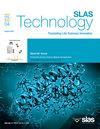Automation of multiplex biochemical assays to enhance productivity and reduce cycle time using a modular robotic platform
IF 2.5
4区 医学
Q3 BIOCHEMICAL RESEARCH METHODS
引用次数: 0
Abstract
Pharmaceutical and biotechnology companies are increasingly being challenged to shorten the cycle time between design, make, test, and analyze (DMTA) compounds. Automation of multiplex assays to obtain multiparameter data on the same robotic run is instrumental in reducing cycle time. Consequently, an increasing need in automated systems to streamline laboratory workflows with the goal to expedite assay cycle time and enhance productivity has grown in industrial and academic institutions in the past decades. Herein, we present a customized robotic platform with operational modularity and flexibility, designed to automate entire assay workflows involving multistep reagent dispensing, mixing, lidding/de-lidding, incubation, centrifugation, and final readout steps by linking spinnaker robot with various peripheral instruments. Compared to manual workflows, the system can seamlessly execute processes with high efficiency, evaluated by standard assay validation protocols for robustness and reproducibility. Furthermore, the system can perform multiple, independent protocols in parallel, and has high-throughput capacity. In this publication, we demonstrate that the modular robotic platform can fully automate multiplex assay workflows through ‘one-click-and-run’ solution with tremendous benefits in liberating manual intervention, boosting productivity while producing high-quality data combined with reduced cycle time (>20 %), as well as expanding the capacity for higher throughput.
自动化的多重生化分析,以提高生产力和减少使用模块化机器人平台的周期时间。
制药和生物技术公司在缩短DMTA化合物的设计、制造、测试和分析周期方面面临着越来越大的挑战。在同一机器人运行中获得多参数数据的多重分析自动化有助于缩短周期时间。因此,在过去的几十年里,工业和学术机构越来越需要自动化系统来简化实验室工作流程,以加快分析周期时间并提高生产力。在此,我们提出了一个具有操作模块化和灵活性的定制机器人平台,旨在通过将spinnaker机器人与各种外围仪器连接起来,自动化整个分析工作流程,包括多步骤试剂分配、混合、盖上/去盖、培养、离心和最终读数步骤。与手动工作流程相比,该系统可以无缝地执行流程,效率高,并通过标准分析验证方案进行鲁棒性和可重复性评估。此外,该系统可以并行执行多个独立的协议,具有较高的吞吐能力。在本出版物中,我们证明了模块化机器人平台可以通过“一点击即运行”的解决方案完全自动化多路分析工作流程,在解放人工干预方面具有巨大的优势,提高了生产率,同时产生了高质量的数据,减少了周期时间(>20%),并扩大了更高吞吐量的容量。
本文章由计算机程序翻译,如有差异,请以英文原文为准。
求助全文
约1分钟内获得全文
求助全文
来源期刊

SLAS Technology
Computer Science-Computer Science Applications
CiteScore
6.30
自引率
7.40%
发文量
47
审稿时长
106 days
期刊介绍:
SLAS Technology emphasizes scientific and technical advances that enable and improve life sciences research and development; drug-delivery; diagnostics; biomedical and molecular imaging; and personalized and precision medicine. This includes high-throughput and other laboratory automation technologies; micro/nanotechnologies; analytical, separation and quantitative techniques; synthetic chemistry and biology; informatics (data analysis, statistics, bio, genomic and chemoinformatics); and more.
 求助内容:
求助内容: 应助结果提醒方式:
应助结果提醒方式:


